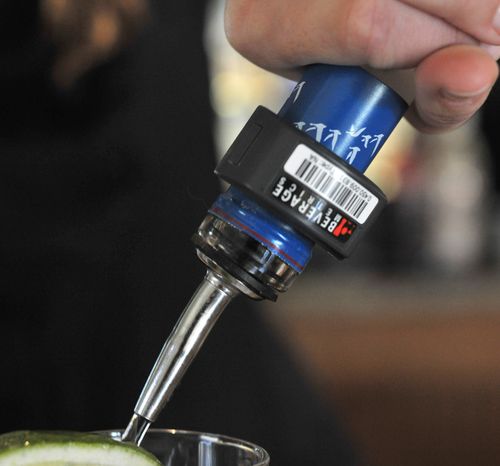Beverage Metrics, a startup company based in California, has commercially released its inventory and drink pour management system for liquor and wine. Currently, the system is being trialed by half a dozen hotels, restaurants and casinos to reduce shrinkage and provide a better view into the inventory of beer, wine and hard liquor.
The company uses RFID battery-powered tags and readers from one of its sister firms, Identec Solutions, as well as software from another of its sister firms, InSync Software, to provide the Beverage Metrics Complete Solution that tracks bottles of liquor. A bar’s manager can use system to measure how much liquor a bartender pours per drink, based on a tilt sensor in the RFID tag, which operates at 919 MHz and uses a proprietary air-interface protocol. That data is intended to prevent excessive pours or other shrinkage issues (such as pouring drinks that aren’t billed for). In addition, the system can provide detailed bar reports at banquets, which can aid in billing customers, such as wedding parties, by tracking exactly how much bottled liquor or wine was poured. If customers choose, they can also use the system to receive an alert if a bottle of liquor or wine disappears from the system (and therefore may have been stolen) or update inventory data to notify management when additional inventory needs to be ordered.
Alcoholic beverage shrinkage plagues the hospitality industry, says Alain Piallat, Beverage Metrics’ CEO. About 25 percent of liquor revenues are lost, on average, he adds.
There is at least one other RFID-enabled drink pour management solution on the market, namely Capton‘s Beverage Tracker (see To Teach Bartenders How to Make Cocktails, Just Add RFID and Vegas Hotel-Casino Uses Tags to Keep Tabs on Liquor). Capton provides an RFID-enabled spout that attaches to the top of a bottle to measure and record the amount of alcohol poured for each drink. The Capton system, however, is not designed for tracking the inventory of unopened bottles.
Beverage Metrics solution has several components. First and foremost, it offers the ability to track the pouring of liquor in bars, by means of a tag on the exterior of the bottle rather than integrated in a spout placed in the bottle’s mouth. When a bar receives a box of liquor from its distributor, its staff can attach the Identec Solutions tag, which is shaped in the form of a ring that wraps around the neck of each bottle. They scan the UPC bar code printed on the box, or on the side of the bottle, then use a handheld device to read the unique ID number encoded to each bottle’s tag, or scan the bar code printed on the RFID tag (also encoded with the tag’s ID number), thereby linking the tag to the bottle in the Beverage Metrics software.
When the bottle goes to the bar, its tag is read by a fixed RFID reader cabled to a PC. A built-in battery powers the transmission of the tag—the tag can be received by a reader up to 100 feet away. The battery also powers the tag’s tilt sensor, which detects when the bottle is inverted and when it is returned to its upright position as well as to what angle it was inverted. The tag stores the sensor data in its memory and transmits it to the reader after ever pour, as well as once every six minutes if the bottle is not moving. The unique ID number of the tag is linked to the specific bottle and its bar-code number in the Beverage Metrics Complete Solution software. That software analyzes data from the tag’s bottle angle sensor to determine how much liquor was poured, to as close as one-tenth of a milliliter.
Beverage Metrics can provide the software as a hosted Web-based solution, or sell it as a software package that runs locally on the end user’s server. The system’s data can be then compared against point-of-sale (POS) data to determine if bartenders are over-pouring or under-pouring. The system can also be used to determine if a bartender is substituting one brand of liquor for another—for example, pouring one brand and billing for another (which could be detected by comparing POS data and Beverage Metrics data).
Another the system’s component is a turbine flow meter to track the amount of beer being poured from a tap, while data from a wired connection to the flow meter installed at the beer tap is saved on the Beverage Metrics software.
For banquets, the system offers a more mobile solution than the one used in permanent bar locations, In this case the system includes PC tablets with built-in RFID readers to capture the ID numbers of tagged bottles at a temporary bar location, such as a garden area of a hotel. The PC tablets are affixed to the portable bar, either under or above a counter, and capture the ID number and tilt data about each bottle as it is used. The banquet manager can then calculate how much was consumed by the guests and send a bill accordingly. The system also allows for changes to the system, such as banquet staff providing a bottle to working at a bar for another party being held in a different room at the same site. The bartender then simply updates the status of the bottle in the software and it can then be used and billed to the party for that specific bar.
Another component of Beverage Metrics solution tracks a bar’s perpetual inventory. Because the tags are attached to the exterior of the bottle, they can be used to track the location of a bottle as soon as the tag is attached, even if the bottle is not yet opened but is in fact still in storage in the backroom. By installing fixed readers in the back room, a bar’s managers can track exactly where bottles are at all time, and if a bottle drops off the system. For instance, if bottle is removed from the back room to replenish an empty bottle at the bar, the RFID reader installed at bar should be able to detect the tag of the new bottle. If the bar’s reader does not, the system will record that anomaly and send an alert to the manager’s cell phone.
The system differs from Capton’s because the tag is not on the spout but rather on the bottle itself, says Piallat. This allows the system to track the bottles even before they are opened and before any spouts are inserted into the bottles by bartenders. Piallat adds that the Web-based software offers more functionality—including warning the management of missing bottles—that no other system offers.
“The preliminary results have been very positive,” Piallat says, according to responses from those trialing the system. He says of the six currently using the system (installations began about six weeks ago), some are pilots and others are full deployments, all in the United States. He adds that businesses in Dubai, Canada and Australia have been speaking with the company about installing the system. “There’s no question that there is a high level of interest,” Piallat says. “They want to solve a problem no one has addressed effectively before this.”



